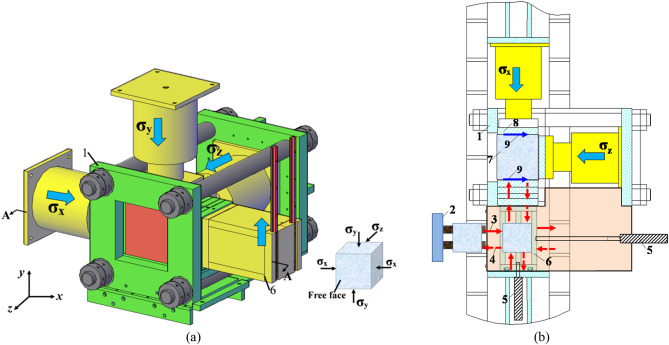JRMGE / Vol 13 / Issue 5
A novel true triaxial test system for microwave-induced fracturing of hard rocks
Xia-Ting Feng, Jiuyu Zhang, Chengxiang Yang, Jun Tian, Feng Lin, Shiping Li, Xiangxin Su
Show More
Key Laboratory of Ministry of Education on Safe Mining of Deep Metal Mines, Northeastern University, Shenyang, 110819, China
2021, 13(5): 961-971. doi:10.1016/j.jrmge.2021.03.008
Received: 2020-12-06 / Revised: 2021-02-01 / Accepted: 2021-03-07 / Available online: 2021-04-29
2021, 13(5): 961-971.
doi:10.1016/j.jrmge.2021.03.008
Received: 2020-12-06
Revised: 2021-02-01
Accepted: 2021-03-07
Available online: 2021-04-29
This study introduces a test system for microwave-induced fracturing of hard rocks under true triaxial stress. The test system comprises a true triaxial stress loading system, an open-ended microwave-induced fracturing system, a data acquisition system, an acoustic emission (AE) monitoring system, and an auxiliary specimen loading system. Microwave-induced surface and borehole fracturing tests under true triaxial stress were fulfilled for the first time, which overcomes the problem of microwave leakage in the coupling loading of true triaxial stress and microwave. By developing the dynamic monitoring system, the thermal response and fracture evolution were obtained during microwave irradiation. The monitoring system includes the infrared thermometry technique for monitoring rock surface temperature, the distributed optic fiber sensing technique for monitoring temperature in borehole in rock, the AE technique and two-dimensional digital speckle correlation technique for monitoring the evolution of thermal damage and the rock fracturing process. To validate the advantages of the test system and investigate the characteristics of microwave-induced fracturing of hard rocks, the study demonstrates the experimental methods and results for microwave-induced surface and borehole fracturing under true triaxial stress. The results show that thermal cracking presented intermittent characteristics (calm–active–calm) during microwave-induced surface and borehole fracturing of basalt. In addition, true triaxial stress can inhibit the development and distribution of thermal cracks during microwave-induced surface fracturing. When microwave-induced borehole fracturing occurs, it promotes the distribution of thermal cracks in rock, but inhibits the width of cracks. The results also prove the reliability of the test system.
Keywords: Deep hard rock engineering, True triaxial apparatus, Microwave-induced fracturing of hard rocks, Electromagnetic compatibility, Dynamic monitoring, Evolution of rock fracturing
Article Data
Author(s) Information
Prof. Xia-Ting Feng
xtfeng@whrsm.ac.cn
fengxiating@mail.neu.edu.cn

Prof. Xia-Ting Feng received his PhD degree at Northeastern University of Technology (now Northeastern University since 1993), China in 1992 and then took the position of lecturer, associate professor and professor at the same university. He joined Institute of Rock and Soil Mechanics, Chinese Academy of Sciences (CAS) in 1998 as a Professor of Hundred Talent Program of the CAS and as Deputy Director in Charge and Director in 2001–2005. He has worked as Director of State Key Laboratory of Geomechanics and Geotechnical Engineering since 2007. He works at Northeastern University, China as a Vice President since September 2017. In February 2021, he became president of Northeastern University. He is President of Federation of International Geo-engineering Societies−FedIGS, President of International Society for Rock Mechanics (ISRM) Commission on Design Methodology, member of ISRM Commission on Testing Methods, and President of Chinese Society for Rock Mechanics and Engineering (CSRME). He was the past President of ISRM 2011–2015. He is also Editor-in-Chief of Journal of Rock Mechanics and Geotechnical Engineering (JRMGE), and Associate Editor-in-Chief of Chinese Journal of Theoretical and Applied Mechanics. He is member of Editorial Board of Rock Mechanics and Rock Engineering. His research interests cover rock mechanics for deep rock engineering. He published more than 200 technical papers and the English books “Rock engineering design” and “Rock engineering risk” with Professor John Hudson. He has edited five volumes of the book “Rock mechanics and rock engineering” (CRC Press) and the book “Rockburst” (Elsevier).

